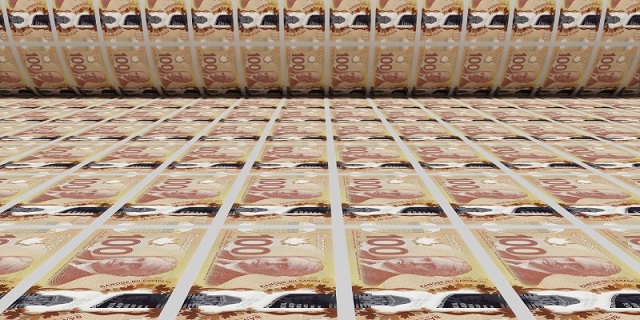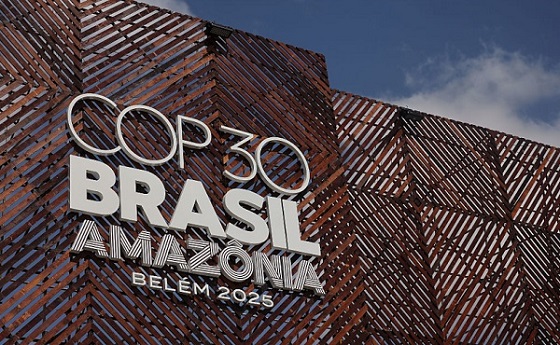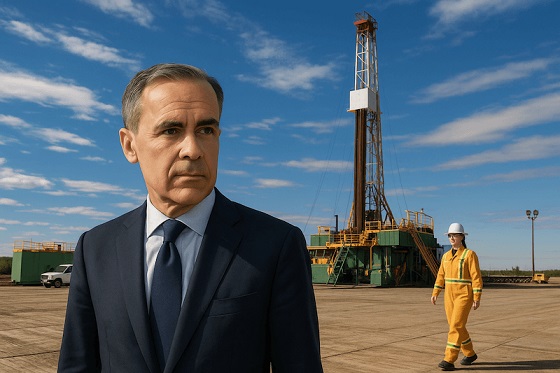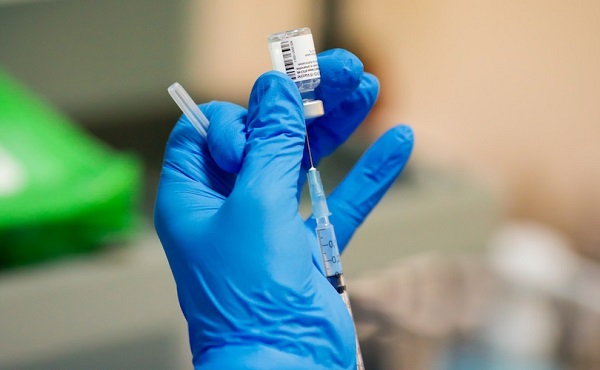Economy
The Cost to Western Canada if Steven Guilbeault Copies Biden’s Assault on LNG

From EnergyNow.ca
By Jim Warren
” if all of the gas exported by Canada to the US from 2014 to 2021, the years encompassing the price depression, had instead been exported to Europe at average European prices, Canadian natural gas revenues would have been US $100.7 billion higher “
What would it cost western Canada’s natural gas producers if the federal government does to them what it did to tidewater export opportunities for petroleum?
This question became topical last week when the Biden Democrats announced they would block construction of new LNG export facilities in the US. It makes sense to get a handle on the size of revenues at stake if future development of LNG export capacity in Canada is similarly at risk. Indeed, it seems quite reasonable to worry that Steven Guilbeault will take inspiration from the Biden decision and try to do something similarly silly in Canada.
Getting pipelines to tidewater is something Canada’s petroleum industry has been counting on to improve export revenues. This was a particularly urgent hope during the eight-year oil price depression that lasted from Fall 2014 until early Winter 2022. It was, and still is, assumed exporting Canadian diluted bitumen (dilbit) into new non-US markets will allow producers to avoid the costly differential charges assessed by American buyers and refiners.
What if scenarios floated during the eight-year price slump showed that had the Northern Gateway and Trans Mountain pipelines been completed, Canadian producers could have earned billions in additional revenues. Estimates of lost revenues ranged from a Fraser Institute estimate of $15.8 billion for 2018 alone to my own low-ball estimate for losses of $7 billion to $9 billion for that same year. Numerous back of the napkin “what if” calculations for lost revenues produced in coffee shops across the prairies helped fuel frustration and anger at federal government environmental policies intended to limit global warming by cancelling pipelines.
Fast forward to 2024 and we can see that similar conditions apply to western Canada’s natural gas sector. The US is virtually the sole export market for Canadian natural gas. Looking back at the period from 2010-2019 we find that the prices paid by US importers for Canadian natural gas were less than half what Europeans were paying. The price spread became exponentially wider beginning in 2016. It peaked in 2022 when the European price was six times higher than the US price. The European gas price will be five times higher than US prices for 2024.
All else being equal, if all of the gas exported by Canada to the US from 2014 to 2021, the years encompassing the price depression, had instead been exported to Europe at average European prices, Canadian natural gas revenues would have been US $100.7 billion higher than what they actually were.
Of course “all else” is far from being equal. The $100.7 billion figure does not account for the cost of converting natural gas to LNG or the added costs of ocean transportation. In addition, the estimate assumes enough Canadian pipelines and tidewater terminals could be built to accommodate all of the gas currently flowing to the US.
The yawning chasm between US and EU prices today is of course largely the result of Russia’s invasion of Ukraine in late February 2022. EU sanctions aimed at Russian energy exports and the destruction of the Nord Stream pipelines has put Europe firmly on track for developing new sources of natural gas.
Notwithstanding the bland platitudes and unreachable targets emanating from the most recent COP conference in the UAE, there are policy makers in many countries who recognize the important role natural gas can play in reducing global GHG emissions. For example, in December 2021 the European Commission made changes to its GHG emissions law. It now allows both nuclear energy and natural gas to be considered suitable transition fuels during the period while renewable options become more viable.
Lately, there has been a popular backlash in Europe and the UK over excessively zealous green transition initiatives. It turns out a lot of people are unwilling to accept additional increases to their cost of living even when told it is necessary to “save the planet.” People won’t stand for a prohibitively expensive green transition. And they never will be willing to freeze in the dark; especially when an acceptable option like natural gas is available.
Biden’s bizarre decision to block the expansion of US LNG export facilities was probably not motivated by a desperate desire or useful effort to curb GHG emissions. It is more likely a ham-handed attempt to staunch the Democrats’ loss of support among the young and the woke. Regardless of Biden’s motivation, we might reasonably worry that Canada’s environment minister will want to copy him. You might think the collapse in support for Canada’s Liberals and common sense would militate against the imposition of any additional half-baked environmental policy. But when has common sense ever intervened in the creation of environmentally virtuous policy on the part of the Liberals in Ottawa?
I have provided my data sources and relevant tables below
Hypothetical question: What if the exports to the US had been exported to Europe?

Source: derived by the author from the sources and data provided below
Natural gas prices for the US and Europe 2022 to 2024 in US$ per million British thermal units (BTUs) 2023 and 2024 figures are forecasts.*

Source: derived from Statist: Natual gas commodity prices in Europe and the United States from 1980 to 2022 with forecasts for 2023 and 2024.
https://www-statista-com.libproxy.uregina.ca/statistics/252791/natural-gas-prices/
Canadian natural gas exports in billion cubic metres (all to US)

Source: Statista. Natural gas exports by pipeline from Canada from 2010 to 2021 (in billion cubic metres).
https://www-statista-com.libproxy.uregina.ca/statistics/567703/natural-gas-exports-from-canada/
Natural gas prices for the US and Europe 2010 to 2024 in US$ per million British thermal units (BTUs) 2023 and 2024 figures are forecasts.*

Source: Statista: Natural gas commodity prices in Europe and the United States from 1980 to 2022 with forecasts for 2023 and 2024.
https://www-statista-com.libproxy.uregina.ca/statistics/252791/natural-gas-prices/
Business
Ottawa Pretends To Pivot But Keeps Spending Like Trudeau

From the Frontier Centre for Public Policy
New script, same budget playbook. Nothing in the Carney budget breaks from the Trudeau years
Prime Minister Mark Carney’s first budget talks reform but delivers the same failed spending habits that defined the Trudeau years.
While speaking in the language of productivity, infrastructure and capital formation, the diction of grown-up economics, it still follows the same spending path that has driven federal budgets for years. The message sounds new, but the behaviour is unchanged.
Time will tell, to be fair, but it feels like more rhetoric, and we have seen this rhetoric lead to nothing before.
The government insists it has found a new path, one where public investment leads private growth. That sounds bold. However, it is more a rebranding than a reform. It is a shift in vocabulary, not in discipline. The government’s assumptions demand trust, not proof, and the budget offers little of the latter.
Former prime ministers Jean Chrétien and Paul Martin did not flirt with restraint; they executed it. Their budget cuts were deep, restored credibility, and revived Canada’s fiscal health when it was most needed. Ottawa shrank so the country could grow. Budget 2025 tries to invoke their spirit but not their actions. The contrast shows how far this budget falls short of real reform.
Former prime minister Stephen Harper, by contrast, treated balanced budgets as policy and principle. Even during the global financial crisis, his government used stimulus as a bridge, not a way of life. It cut taxes widely and consistently, limited public service growth and placed the long-term burden on restraint rather than rhetoric. Carney’s budget nods toward Harper’s focus on productivity and capital assets, yet it rejects the tax relief and spending controls that made his budgets coherent.
Then there is Justin Trudeau, the high tide of redistribution, vacuous identity politics and deficit-as-virtue posturing. Ottawa expanded into an ideological planner for everything, including housing, climate, childcare, inclusion portfolios and every new identity category.
The federal government’s latest budget is the first hint of retreat from that style. The identity program fireworks are dimmer, though they have not disappeared. The social policy boosterism is quieter. Perhaps fiscal gravity has begun to whisper in the prime minister’s ear.
However, one cannot confuse tone for transformation.
Spending still rises at a pace the government cannot justify. Deficits have grown. The new fiscal anchor, which measures only day-to-day spending and omits capital projects and interest costs, allows Ottawa to present a balanced budget while still adding to the deficit. The budget relies on the hopeful assumption that Ottawa’s capital spending will attract private investment on a scale economists politely describe as ambitious.
The housing file illustrates the contradiction. New funding for the construction of purpose-built rentals and a larger federal role in modular and subsidized housing builds announced in the budget is presented as a productivity measure, yet continues the Trudeau-era instinct to centralize housing policy rather than fix the levers that matter. Permitting delays, zoning rigidity, municipal approvals and labour shortages continue to slow actual construction. These barriers fall under provincial and municipal control, meaning federal spending cannot accelerate construction unless those governments change their rules. The example shows how federal spending avoids the real obstacles to growth.
Defence spending tells the same story. Budget 2025 offers incremental funding and some procurement gestures, but it avoids the core problem: Canada’s procurement system is broken. Delays stretch across decades. Projects become obsolete before contracts are signed. The system cannot buy a ship, an aircraft or an armoured vehicle without cost overruns and missed timelines. The money flows, but the forces do not get the equipment they need.
Most importantly, the structural problems remain untouched: no regulatory reform for major projects, no tax-competitiveness agenda and no strategy for shrinking a federal bureaucracy that has grown faster than the economy it governs. Ottawa presides over a low-productivity country but insists that a new accounting framework will solve what decades of overregulation and policy clutter have created. The budget avoids the hard decisions that make countries more productive.
From an Alberta vantage, the pivot is welcome but inadequate. The economy that pays for Confederation receives more rhetorical respect, yet the same regulatory thicket that blocks pipelines and mines remains intact. The government praises capital formation but still undermines the key sectors that generate it.
Budget 2025 tries to walk like Chrétien and talk like Harper while spending like Trudeau. That is not a transformation. It is a costume change. The country needed a budget that prioritized growth rooted in tangible assets and real productivity. What it got instead is a rhetorical turn without the courage to cut, streamline or reform.
Canada does not require a new budgeting vocabulary. It requires a government willing to govern in the country’s best interests.
Marco Navarro-Genie is vice-president of research at the Frontier Centre for Public Policy and co-author with Barry Cooper of Canada’s COVID: The Story of a Pandemic Moral Panic (2023).
Daily Caller
Paris Climate Deal Now Decade-Old Disaster


From the Daily Caller News Foundation
By Steve Milloy
The Paris Climate Accord was adopted 10 years ago this week. It’s been a decade of disaster that President Donald Trump is rightly trying again to end.
The stated purpose of the agreement was for countries to voluntarily cut emissions to avoid the average global temperature exceeding the (guessed at) pre-industrial temperature by 3.6°F (2°C) and preferably 2.7°F (1.5°C).
Since December 2015, the world spent an estimated $10 trillion trying to achieve the Paris goals. What has been accomplished? Instead of reducing global emissions, they have increased about 12 percent. While the increase in emissions is actually a good thing for the environment and humanity, spending $10 trillion in a failed effort to cut emissions just underscores the agreement’s waste, fraud and abuse.
As a nonprofit, we are dependent on the generosity of our readers.
Please consider making a small donation of any amount here.
Thank you!
But wasting $10 trillion is only the tip of the iceberg.
The effort to cut emissions was largely based on forcing industrial countries to replace their tried-and-true fossil fuel-based energy systems with not-ready-for-prime-time wind, solar and battery-based systems. This forced transition has driven up energy costs and made energy systems less reliable. The result of that has been economy-crippling deindustrialization in former powerhouses of Germany and Britain.
And it gets worse.
European nations imagined they could reduce their carbon footprint by outsourcing their coal and natural gas needs to Russia. That outsourcing enriched Russia and made the European economy dependent on Russia for energy. That vulnerability, in turn, and a weak President Joe Biden encouraged Vladimir Putin to invade Ukraine.
The result of that has been more than one million killed and wounded, the mass destruction of Ukraine worth more than $500 billion so far and the inestimable cost of global destabilization. Europe will have to spend hundreds of billions more on defense, and U.S. taxpayers have been forced to spend hundreds of billions on arms for Ukraine. Putin has even raised the specter of using nuclear weapons.
President Barack Obama unconstitutionally tried to impose the Paris agreement on the U.S. as an Executive agreement rather than a treaty ratified by the U.S. Senate. Although Trump terminated the Executive agreement during his first administration, President Joe Biden rejoined the agreement soon after taking office, pledging to double Obama’s emissions cuts pledge to 50 percent below 2005 levels by 2030.
Biden’s emissions pledge was an impetus for the 2022 Inflation Reduction Act that allocated $1.2 trillion in spending for what Trump labeled as the Green New Scam. Although Trump’s One Big Beautiful Bill Act reduced that spending by about $500 billion and he is trying to reduce it further through Executive action, much of that money was used in an effort to buy the 2024 election for Democrats. The rest has been and will be used to wreck our electricity grid with dangerous, national security-compromising wind, solar and battery equipment from Communists China.
Then there’s this. At the Paris climate conference in 2015, U.S. Secretary of State John Kerry stated quite clearly that emissions cuts by the U.S. and other industrial countries were meaningless and would accomplish nothing since the developing world’s emissions would be increasing.
Finally, there is the climate realism aspect to all this. After the Paris agreement was signed and despite the increase in emissions, the average global temperature declined during the years from 2016 to 2022, per NOAA data.
The super El Nino experienced during 2023-2024 caused a temporary temperature spike. La Nina conditions have now returned the average global temperature to below the 2015-2016 level, per NASA satellite data. The overarching point is that any “global warming” that occurred over the past 40 years is actually associated with the natural El Nino-La Nina cycle, not emissions.
The Paris agreement has been all pain and no gain. Moreover, there was never any need for the agreement in the first place. A big thanks to President Trump for pulling us out again.
Steve Milloy is a biostatistician and lawyer. He posts on X at @JunkScience.
-

 Digital ID2 days ago
Digital ID2 days agoCanada releases new digital ID app for personal documents despite privacy concerns
-

 Community1 day ago
Community1 day agoCharitable giving on the decline in Canada
-

 Bruce Dowbiggin2 days ago
Bruce Dowbiggin2 days agoNFL Ice Bowls Turn Down The Thermostat on Climate Change Hysteria
-

 Energy2 days ago
Energy2 days agoCanada’s sudden rediscovery of energy ambition has been greeted with a familiar charge: hypocrisy
-

 Crime2 days ago
Crime2 days agoTrump designates fentanyl a ‘weapon of mass destruction’
-

 Energy2 days ago
Energy2 days agoCan we not be hysterical about AI and energy usage?
-

 Energy2 days ago
Energy2 days agoEnergy security matters more than political rhetoric
-

 Alberta1 day ago
Alberta1 day agoCanada’s New Green Deal






